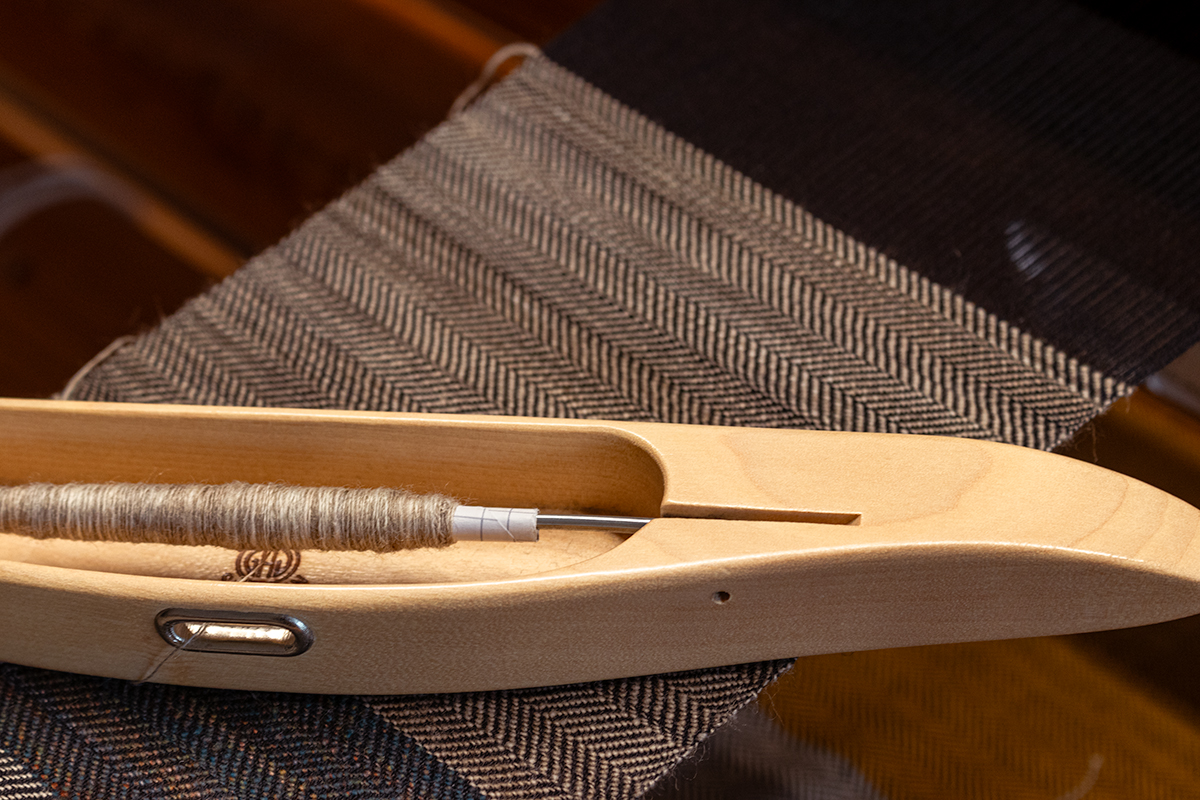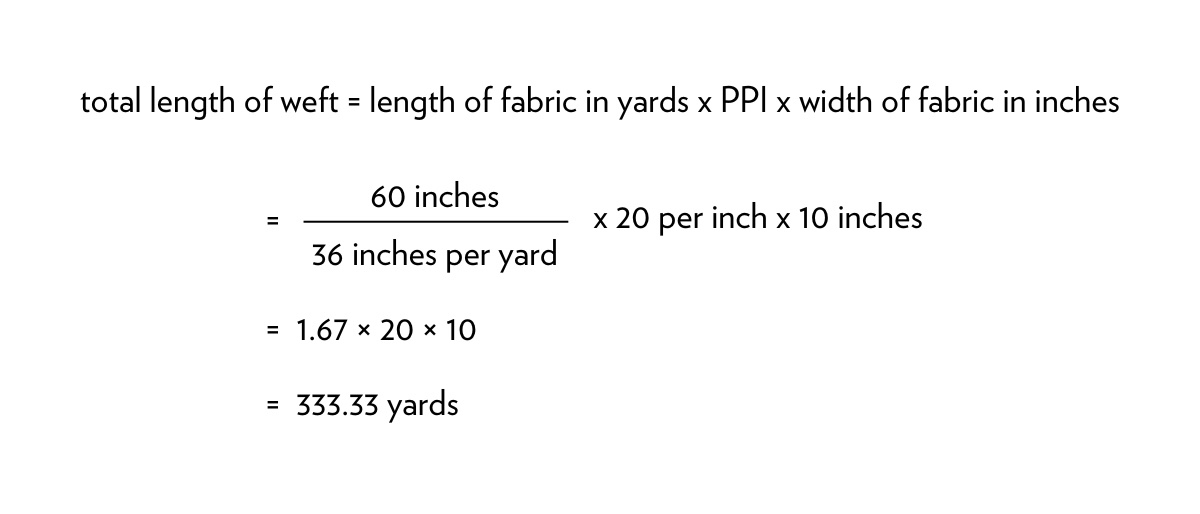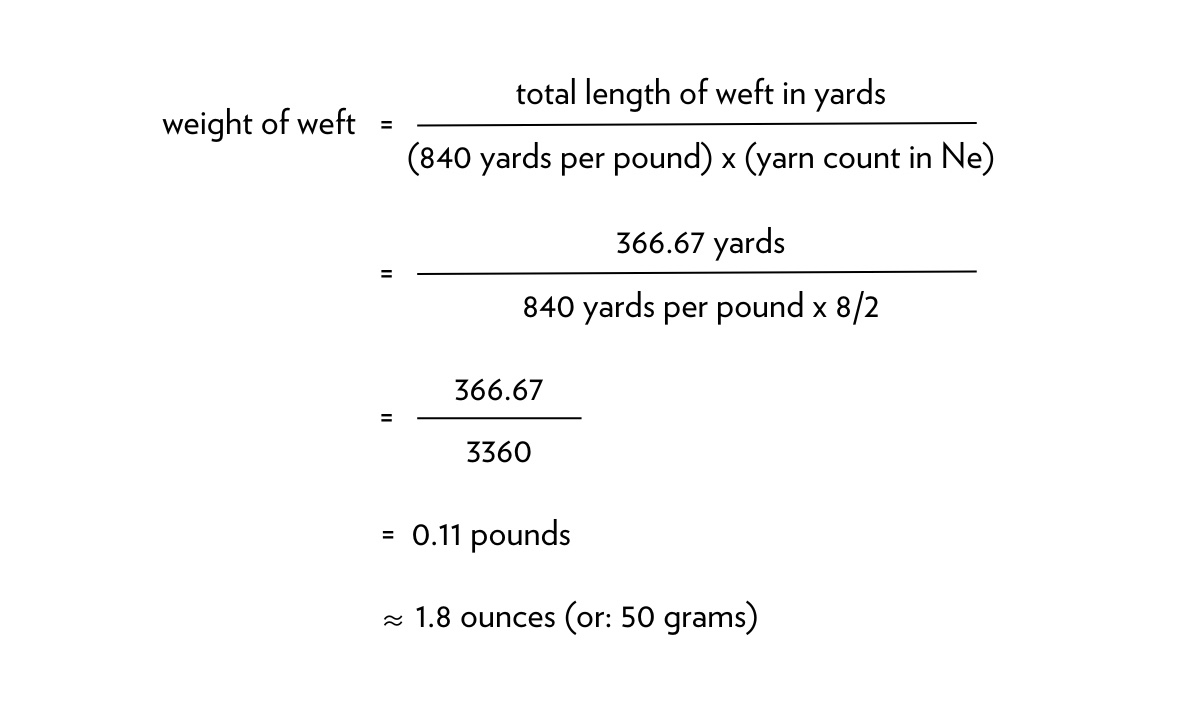How to Estimate the Amount of Weft Yarn for Any Weaving Project
If you’re planning to weave a piece of fabric, one thing you will want to know is how much weft yarn you will need. The amount of weft you need will depend on things like the width and length of your fabric, the sett of your warp and weft, the type and weight of your yarn, and the weave structure you are using.
Let’s look at how to calculate the approximate amount of weft yarn for a weaving project, using some simple formulas and an example.
Calculating Weft Length
Yarn is usually sold by weight, such as 100-gram skeins, 250-gram spools, or even 1-kg cones. To calculate how much weft yarn is needed (whether we buy a new acquisition or use something already in our stash), we first need to figure out how much yardage (length of yarn) we will use. To do this, we need to know:
- The length of our fabric, in inches or centimetres
- The width of our fabric, in inches or centimetres
- The sett, or ends per inch (EPI), of our warp
- The sett, or picks per inch (PPI), of our weft
- The percentage of shrinkage and take-up of our yarn
Step One: Working in Two Dimensions
First up, we know the width of the fabric on the loom, so let’s use this as our initial guestimate of how much weft yarn we use when we throw the shuttle once to form a pick.
Next, the weft sett tells us how many picks we need to throw to produce a unit length of fabric. This is usually an inch of fabric for imperial measurements and a centimetre of fabric for metric measurements. So, if we multiply the width of the fabric by the weft sett, we get a value for how much weft yarn we need to produce a unit length of fabric.
And finally, we have a length of fabric we want to weave. If we multiply the amount of weft yarn needed to produce a unit length of fabric by the total length of fabric, we have an estimate of the weft yarn we need to weave that fabric.
As a formula:
Approx. Total Length of Weft = Width of the Fabric x Weft Sett x Length of the Fabric
Step Two: Refining our Estimate for the Real World
We now have an idea of how much weft yarn we need, but it isn’t really a good enough estimate in practice.
Fabric isn’t two-dimensional—it is three-dimensional. The warp and the weft travel over and under each other, and the paths that they take aren’t perfectly flat and straight. That extra bit of yarn that gets used to go over and under is called the take-up. Since the take-up is dependent on the path the yarn takes, then the amount of take-up is different for different weave structures and setts.
The fabric also undergoes changes when we wet finish it. The change here is known as the shrinkage. Different types of yarns, different ways of washing, different methods of pressing, different amounts of fulling… there are lots of factors which impact shrinkage from project to project.
And this, my friends, is where it pays to sample! If you weave a sample of your cloth and measure the width in the reed compared to the finished width (and the woven vs finished length), you can figure out the exact percentage allowance for shrinkage and take-up.
(Want to skip the sampling? For balanced weaves and square setts, many weavers add a 10-15% allowance as an average shrinkage and take-up factor in both the warp and the weft).
Whichever way we get to our take-up and shrinkage allowance, we can now use it to refine our weft yarn estimate. So, for example, if need to add 10% for our shrinkage and take-up allowance, we can multiply our Step One estimate by 1.1 to get our new and refined estimate for the length of weft yarn we need for our project.
Summary: Formula for Calculating Weft Yarn Length
Total Length of Weft
= Width of the Fabric x Weft Sett x Length of the Fabric x Shrinkage & Take-Up Factor

Calculating Weft Weight
Now that we know how long our weft yarn will be, we can calculate how much it will weigh. To do this, we need to know:
- The total length of weft in yards or metres
- The count or weight of your weft yarn (a.k.a. linear density or grist)
How to calculate weft weight is different depending on what type of count your yarn uses. The aim here is that the units in the formula need to cancel out to give us a unit of weight (e.g., pounds or kilograms) in the end.
Option One: Direct Yarn Counts
Also known as fixed-length systems, these yarn numbering systems are based on weight per unit length. The bigger the yarn count, the larger the yarn. Tex and Denier are examples of direct yarn counts.
For these yarns:
Total Weight of Weft = Total Length of the Weft x Yarn Count of the Weft
Option Two: Indirect Yarn Counts
Also known as fixed weight systems, these yarn numbering systems are based on length per unit weight. The bigger the yarn count, the smaller the yarn. Ne, NeL, and GC are examples of indirect yarn counts.
For these yarns:
Total Weight of the Weft = Total Length of the Weft ÷ Yarn Count of the Weft
For example, cotton yarns are often measured in Ne, where one Ne is 840 yards per pound. A Ne 4 yarn means that 4 hanks of 840 yards weigh one pound, or in other words, 3360 yards per pound of yarn. In this case, converting to yards per pound allows us to use the formula below to calculate the total weight of weft in pounds.
Total Weight of the Weft (in pounds)
=Total Length of the Weft (in yards) ÷ Yarn Count of the Weft (in yards per pound)
Let’s Do An Example Together!
You want to weave a plain weave runner with Ne 8/2 cotton yarn. The finished dimensions of your scarf are 10 inches wide and 60 inches long. You have set your warp at 20 EPI and plan to weave with 20 PPI. Your yarn has a shrinkage and take-up factor of 10%. How much weft yarn do you need?
First, calculate the total length of weft:

Then, multiply by the shrinkage and take-up factor:

Next, calculate the weight of weft:

Therefore, you need about 50 grams of Ne 8/2 cotton yarn for your project weft.
Tips and Resources for Weaving Calculations
- It is great to know how to do these calculations and to be able to step through them, but once you know what is going on, you can make these calculations easier using a weaving calculator tool or a spreadsheet. For example, Felicia Lo has included a Google Sheets file for you in the Double-Weave on 4 Shafts course at the School of SweetGeorgia.
- To measure the WPI, EPI, and PPI of your yarn and fabric, you can use a ruler, a tape measure, or a special gauge. You can also calculate WPI for your yarn if you want more math!
- To sample for shrinkage and take-up of your yarn and fabric, weave a small piece of fabric with the same yarn, sett, PPI, and weave structure as your project, then wash and finish it as you would your final product. Measure the dimensions before and after washing and compare them to calculate the percentage of shrinkage and take-up.
- You’ll find tables of conversions for yarn counts in all good weaving books, and sometimes even in spinning books. Luckily for us, Laura Fry included many of the common ones in her article about yarn counts.
Happy weaving!
Original publication: October 5th, 2023; Refreshed: February 6th, 2025
Interested in further exploring weaving techniques, tips, project inspiration, and more? We invite you to join us at the School of SweetGeorgia! Check out the range of online weaving courses there paired with a fabulous community of makers and help from experienced instructors to help you with questions along the way! Use the code EXPLOREWITHUS to access a 14-day trial for just $1! We look forward to seeing you inside the School!
The post How to Estimate the Amount of Weft Yarn for Any Weaving Project appeared first on SweetGeorgia Yarns.
Comments
Post a Comment